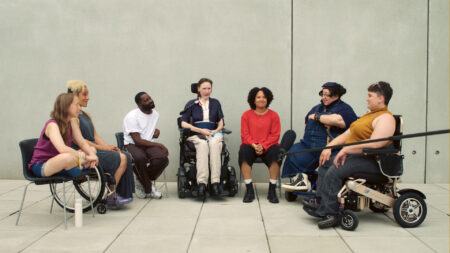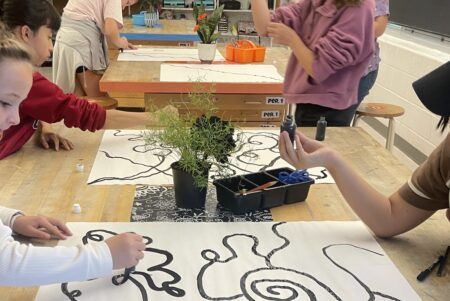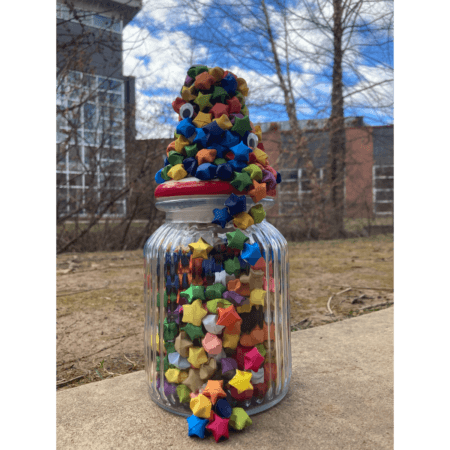Teaching with Contemporary Art
Finding Contemporary Artists for the Classroom — An Entry Point

IMAGE: Deborah Roberts, Let Them Be Children, 2018.
No Set Canon — Finding Contemporary Artists
How many of us still have Gardner’s Art Through the Ages anchoring our bookcases to the ground? It’s a great, yet heavy reference capturing a range of human creativity, spanning from the stone age to the modern era. Gardner’s canon curates significant works of art throughout history, documenting the ways in which humans live, think, act, react, make, and innovate.
These classic works help us explore and understand how and why art was created in particular contexts. Contemporary art, however, requires its own set of references, its own canonical foundation — a new set of pages, a new array of books! With all the scale and complexity of these works, the lack of a solid, singular reference text gives us pause: Why are there so many texts covering contemporary art without one all-encompassing go-to reference?
Covering most aspects of the human experience and a multitude of perspectives, the contemporary art world continues to expand and flow beyond definitions, media, and art movements. One question I am often asked about teaching with contemporary art is, “Where do you find contemporary artists to present in the classroom?” Until something like Gardner’s Art Through the Ages (maybe something to the tune of Contemporary Art and Beyond…) is created to chronologically flip through like the curated cannon of the past, it might seem overwhelming to compose a list of contemporary artists for the classroom. Where to begin?
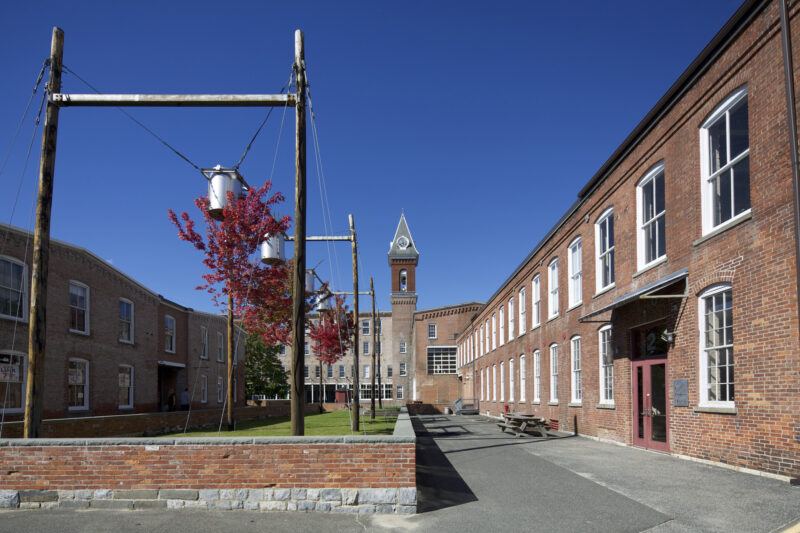
IMAGE: Natalie Jeremijenko, Tree Logic, 1999. Photo: Zoran Orlic.
Transforming Ideas — Art with Denise & Eleanor
First, it’s important to note that my own thinking about art history and contemporary art transformed during graduate school when curator Denise Markonish of Mass MoCA presented at my university, followed by a visit to the exhibit. I was not thrilled to attend a talk about landscape art, but Badlands – New Horizons in Landscape was nothing I could have expected. This work pushed traditional representations of landscapes into the 21st Century; Markonish curated a body of artwork examining a vast expanse of topics concerning the land. Approaching the museum, viewers were confronted with Jeremijenko’s monumental installation of trees plunging downward towards the earth from between telephone poles above. This forced reversal upon the trees’ limbs conjured thoughts of how humans intervene in nature. However, the tree’s eventual reach, curving upward towards the sun, shows us that mother nature will find a path to prevail. Jeremijenko’s work addressed negative human interactions with the landscape by displaying unconventional objects in an unconventional manner. I wondered how I might also prompt students to reconsider materials and possibilities for display?
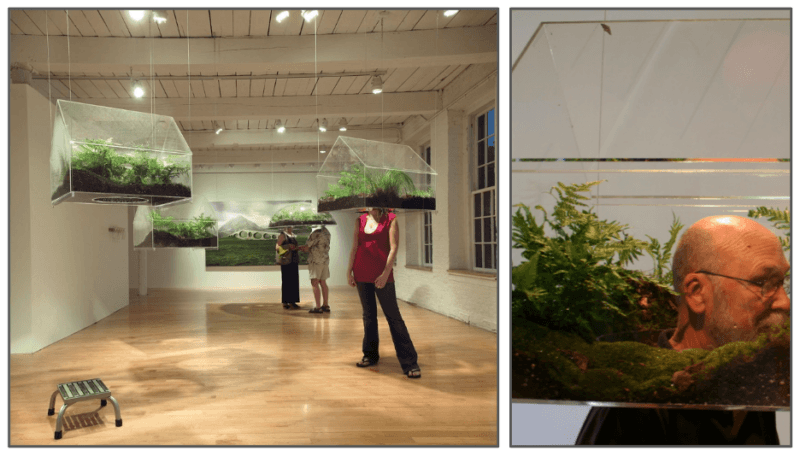
IMAGE: Vaughn Bell, Village Green — Personal Home Biospheres, 2008.
Vaughn Bell’s Personal Home Biospheres helped me to expand the ways in which I thought about how artwork could be displayed and interacted with, and what materials could be used. Engaging with the biospheres allowed me to further consider the ways our senses could be involved in the process of experiencing art. With my head inside a biosphere, the world outside the clear plexiglass encasing my view disappeared. The smell of damp earth filled the space, moist plants brushed across my skin, and another face appeared before mine. I was suddenly eye-to-eye with a stranger, noses nearly touching, taking in each others’ breaths. The biospheres were strung from various heights: some too high to be accessed by everyone while others so low that they were inaccessible to all. These aspects, from the use of tactile interactions to the concept of accessibility, were additional considerations to make available to students creating experiential art.
Jacobsen‘s painting The Final Record of the Last Moment of History harkens back to the realism of traditional landscape painting. The mounds of contemporary discarded objects are nearly camouflaged as massive hills littered amongst the mountains. Jacobsen’s painting is a poignant example of how students might juxtapose a traditional style of art with a contemporary topic. Further strolling through the exhibit at Mass MoCA, I encountered Northeast Corner, Southwest Light (2008) by Mary Temple (a similar work, 23.5° [Autumn] from the series, Light Installations, 2002-present is pictured above). The shadows of intricate branches and leaves on the walls of an unusually empty gallery space caused me to turn and look out the window. Instead of dense foliage staring back at me, there was only a blank wall. The shadows had been painted into the gallery space. I then wondered how Temple’s work might encourage students to consider our everyday and mundane contact with nature and light. What can these works teach us about the concepts of permanence and change?
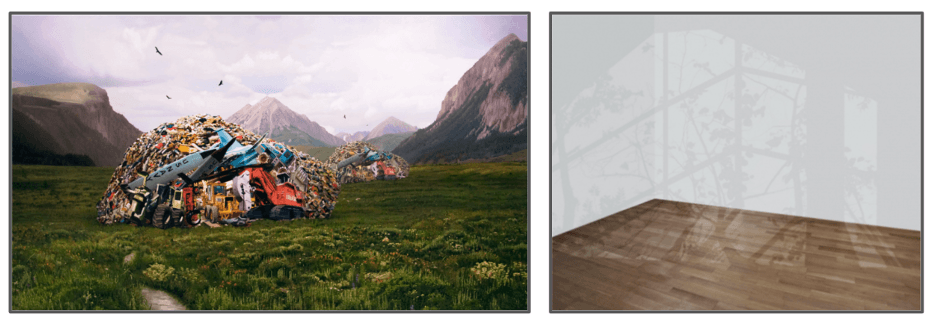
Left IMAGE: Paul Jacobsen, The Final Record of the Last Moment of History, 2007.
Right IMAGE: Mary Temple, 23.5° (Autumn) from the series, Light Installations, 2002-present.
Around the time of Markonish’s talk and our visit to Mass MoCA, we began reading Art & Today (2008) by art critic Eleanor Heartney. Heartney brilliantly shifted the traditional art narrative from previously separated definitions of art movements to contemporary artists working within and around themes such as narratives, time, nature and technology, deformation, the body, identity, spirituality, globalism, and more, by focusing on how artists explored unconventional media or unorthodox uses or displays of traditional materials. In the chapter on Art & Nature and Technology – Remaking Land and Body, Heartney highlights Kac’s green, glowing fluorescent GFP Bunny, infused with a modified jellyfish gene, which causes us to question humanity’s ability and right to play God. Ukeles’ The Social Mirror serves as a moving reflection of our own human actions and their repercussions. Chin’s Revival Field utilizes specific plants that leach toxins from the soil, returning a man-made wasteland into fertile ground.

Mel Chin. Revival Field, 1991. Pig’s Eye Landfill, St. Paul, Minnesota. Plants, and industrial fencing on a hazardous waste landfill; approximately 60 × 60 × 9 feet. Courtesy of the artist.
For me, each of these artworks from Heartney’s chapter fit the theme of Badlands – New Horizons in Landscape and addressed issues of the land today. These topics were real and relevant for students, providing interdisciplinary entry points to approach art. Many of these artists mentioned either collaborate with or are themselves scientists, sociologists, or engineers. Calling attention to these overlaps might ignite the interest of students who may otherwise view art as something that only ‘born-artists’ or ‘born-creatives’ do. Contemporary artists debunk this myth and provide throughlines to connections in visual art. Markonish and Heartney transformed the way in which I view and teach about historical works of art and their relationships with contemporary art and artistic practices. I continue to utilize artwork from Badlands and Art & Today in my curriculum because the works remain relevant.
Where to Look — To the Artworld!
As artist-educators, we all have interests, curiosities, and a propensity to explore and experiment. Interestingly enough, this sounds much like the steps in conducting research. So let’s explore our surroundings, objects, materials, and artists! Let’s experiment with curating artist lists to engage our students in questions that will hopefully lead to more questions! Let’s test out our ideas with our students and, in turn, have our students test out their own ideas with their peers and community! And let’s engage iteratively, getting feedback and trying again!
Observing how contemporary artists work, collect, collaborate, develop ideas, and come to know and express those ideas provides us with so many avenues into art from various topics, themes, lived experiences, and perspectives. Where, then, do we find the contemporary canon? As artist-educator-researchers, we can use our skills in exploring and collecting to create our own evolving, diverse lists of contemporary artists! Art21 Educators is a great and expansive reference and here are a few more to add to your list.
Here are three ways I like to discover contemporary artists:
I. Close to Home
I like to start close to home by attending and promoting local museum and gallery exhibitions. I provide students and families with exhibition and event details. My students and I bring pictures back to the classroom to share with everyone and discuss.
What local art events or exhibits are taking place in your hometown this year?
II. The Surround
I always keep my eyes open for exhibits in surrounding cities and states. Whether I am traveling for work or for fun, I check my destination’s local exhibitions and plan travel around the museum or gallery hours. This summer I planned a camping trip to Bentonville, Arkansas, because I wanted to view The Dirty South – Contemporary Art, Material Culture, and the Sonic Impulse at Crystal Bridges; A Divided Landscape at the Momentary; and Truth or Dare: A Reality Show at 21c Museum Hotel. While in New York with Art21 Educators, I made sure to visit the Whitney Biennial 2022: Quiet as it’s Kept, and Garmenting: Costume as Contemporary Art at the Museum of Arts & Design. On my way to a campsite in Colorado, I swung through Denver to catch an augmented reality exhibition at the Denver Botanical Garden called Seeing the Invisible.
Each of these exhibits displayed artwork from diverse artists working with a variety of media and topics. I documented most of the artwork and exhibition tags to curate into my curriculum, along with proper citations. Many exhibitions offer exhibition guides or books for purchase, but I often find most information I need online through press releases or reviews. As artist-educator-researchers, it is our passion to experience and share art, and I have found that students enjoy seeing photos I’ve taken to share in the classroom. As well, designing my travel itineraries around exhibitions has always made my travels even more enjoyable.
Are there any surrounding cities you might consider swinging through during future travel this year? How will you share the art that you discover there with your students?
Below are several artworks I selected from the three exhibits in Arkansas this summer to include in our curriculum as we explore the history of landscape paintings and our current associations with landscape.

Brian Jungen, Tombstone, 2019. Photo courtesy of the author.
Beasley explores the ability of materials, such as cotton, to evoke history of place. The cotton manufacturing empire in the United States was made possible by the enslavement and disenfranchisement of African Americans, and shipped overseas to trade with Europe. “By encasing these potent materials within a resin slab, Beasley puts these three histories and relationships front and center” (exhibition tag).
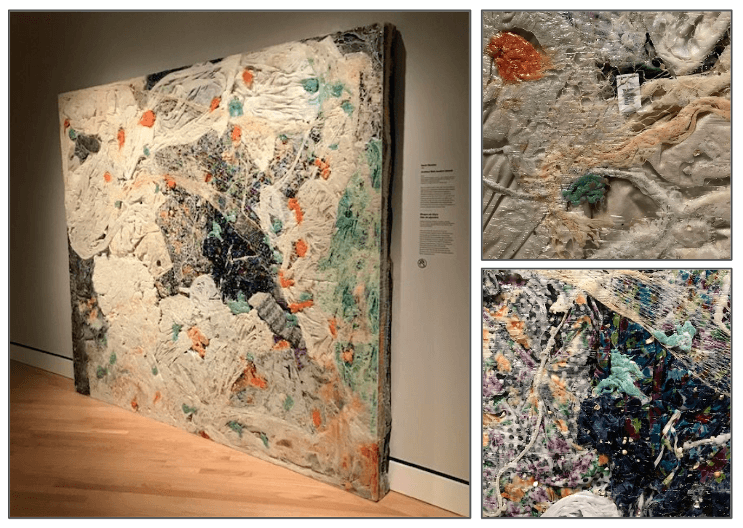
Kevin Beasley, Untitled Slab (cotton island), 2018. Photos courtesy of the author.
III. In Print
I enjoy visiting and working in libraries. When I’m there, I often dash directly to the magazines. As a teacher, I can’t fund my own collection of art publications, but I can peruse them at my leisure in the library. If they don’t carry the subscription I need, I can always put in a request for the publication to be considered. Libraries are a great, thrifty resource! I also like to model for students how I use the public or university libraries by bringing my findings back to the classroom. A few magazines I enjoy flipping through for contemporary artist ideas are ARTnews, Artforum, Art Monthly, Sculpture, American Craft, and Ceramics Monthly. I have also referenced contemporary art stories from issues of Dwell and Architectural Digest. Lapham’s Quarterly, a literary magazine, is also a favorite of mine for interdisciplinary connections because it curates historical classics from a wide range of disciplines, amplifying our present with advice from our past. Pictured below are a few selected references from a 2019 volume on climate:

Top IMAGES: Rachelle Reichert, Salt Circle (small), 2017. Cai Guo-Qiang, Heritage, 2013.
Bottom IMAGES: Henk van Rensbergen, Arlette, from the series No Man’s Land, 2016. Lars Jan, Untitled light box from the ongoing project “Holoscenes,” in which performers are flooded by water, 2014.
Which art magazines interest you? How about publications on related topics, such as architecture, historical objects, interior design, graphic design, furniture design, product design, package design, fashion, or virtual reality? Start with your own passion, and your excitement will spread, inspiring your students to explore their own passions!
By exploring locally, in surrounding neighborhoods and cities, and within magazines, books, and other media sources, your curiosity will keep you hopping down rabbit trails of contemporary artists. You might curate your lists based on themes, on the use of media (conventional or unconventional), on how and where the artwork is displayed or interacted with, or maybe based on a selection of artworks from current exhibitions. It’s fun to watch students discover the unifying factors of the curated work, and even more exciting to see them make connections and their own meaning.
